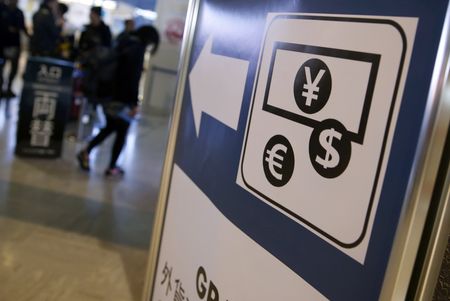
By Alun John
HONG KONG (Reuters) – The yen extended its decline on Monday and the euro and sterling came under pressure, with investors awaiting Federal Reserve chair Jerome Powell’s remarks later in the day and other central bank policymakers this week for monetary policy clues.
The dollar climbed slightly on the yen to as much as 119.3 yen challenging the six-year peak of 119.39 touched on Friday. The dollar finished last week 1.6% higher versus the Japanese currency.
Analysts at CBA said they thought moves in the pair could slow this week, but they predict the dollar will climb further on the yen in the coming months as the gap between U.S. and Japanese interest rates widens.
“Japan’s inflation dynamic is very different to that experienced in other major economies we monitor, As a result, an exit from the ultra-easy monetary policy by the Bank of Japan remains a long way off in our view,” they said.
In contrast, the U.S. central bank raised its key interest rate by 25 basis points last week for the first time since the pandemic.
Traders’ focus is now firmly on the speed and size of future rate hikes and the height of their eventual peak, as policy makers try to curb soaring inflation.
A series of speeches by Fed policymakers this week, kicked off by Powell on Monday, could provide some clues. At least one Fed speaker is due each day this week and Powell himself making another appearance on Wednesday.
Markets will be watching to see the attitude of more dovish Fed policymakers, said analysts at Barclays in a note to clients, saying that if they should sound hawkish it would reinforce expectations of more aggressive rate rises early in the Fed’s path to higher rates.
Markets anticipate further rate increases at the Fed’s subsequent meetings, with pricing indicating nearly a 90% chance of at least 75 basis points of increases across the Fed’s May and June meetings, according to the CME’s Fedwatch tool.
Such high expectations helped the dollar climb steadily in the early part of this year, but with several Fed increases already priced in, it could struggle to gain further traction, analysts say.
“Given already-hawkish market expectations of Fed tightening, it is hard to foresee USD strength persisting beyond the near term,” the Barclays analysts added.
The dollar index, which measures the greenback against six peers, was a whisker firmer at 98.335.
The yen also drifted to a four-year low against the rampant Australian dollar, which has benefited from rising commodity prices.
Versus the U.S. dollar, the Aussie was at $0.74 after gaining 1.7% last week.
“The question for this week is how high AUD/USD can go. We judge (it) will face resistance around $0.7516,” said CBA.
The New Zealand dollar was at $0.6909, gearing up to challenge the near four-month high of $0.6899 hit earlier this month.
The euro was at $1.1038, 0.17% lower, and sterling was at $1.3156 off 0.16% with the future direction of both dependent on the war in Ukraine, which has hurt expectations of European economic growth.
In the short term, speeches this week by several policymakers at the European Central Bank, including president Christine Lagarde, could also play a role.
Fighting is continuing to rage in the eastern European country. Ukraine said there is no question of surrendering the city of Mariupol after Russia called on Ukrainian forces on Sunday to lay down arms in the besieged port city.
Also on the agenda in Europe this week is a meeting by the Norwegian Central Bank with a rate hike expected there too.
In cryptocurrency markets, major coins were struggling to find a firm direction. Bitcoin was slightly softer at $41,000 and ether at $2,850.
(Editing by Gerry Doyle and Jacqueline Wong)

